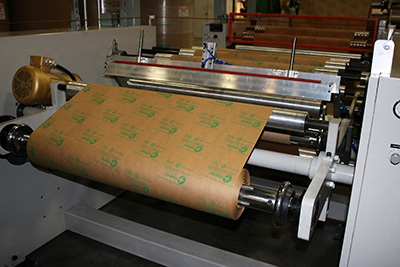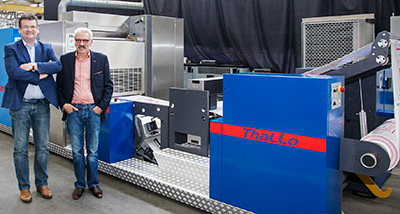PFFC’s Companies to Watch
- Published: April 10, 2020
By Joan Mantini, Editor
At PFFC, we strive to provide the converting and package printing industry with the right resources to succeed. Throughout our journey we are given the privilege to connect with companies all around the world every day and learn what sets them apart. Below we have put together a short list of some of companies worth watching and keeping on your radar in 2020 and beyond.
Digital Printing - ePac
ePac was formed as a result of three partners, Jack Knott, Virag Patel, and Carl Joachim, all with different backgrounds, that somehow came together in 2013 and landed on the same vision - to build a disruptive flexible packaging company, based on digital printing. They saw a way to provide small and medium-sized brands in communities everywhere access to great packaging, ordered to demand. After studying the market in 2014-2015 and developing a business model, ePac was formed and built 100 percent around breakthrough digital printing technology from HP - the Indigo 20000.
In April of 2016, the company opened its first pant in Madison, Wisc. “The market reacted well to us and saw that we provided a service that had never been available before, so we started thinking about ePac as a national and even global business,” said Carl Joachim, co-founder and chief marketing officer at ePac. “Once we entered 2017, we began to execute on our growth strategy, with Boulder, CO being the next location.”
ePac’s founders began with a mission to supply locally-based consumer packaged goods companies with great packaging to compete with large brands, many of which are predominantly locally-based CPGs, whom are focused on providing healthy eating options that are natural and filler-free.
“Since our beginning in 2016 our mission has been clear - to help small brands become big brands, to enable the growth of healthy eating options in our society and in the communities we serve, and to create local employment opportunities that provide our employees the ability to increase their standard of living,” said Joachim.
ePac currently has 10 locations throughout the U.S., one plant in the UK, and plans are underway to expand into the Asia-Pacific region. By the end of 2020, the company states it will have more than 20 locations globally.
“We have low minimum order quantities, no plate fees, produce true photo-quality graphics, and can customize every package we produce. Our customers go to market faster, launch more promotions and can make changes on the fly,” said Joachim.
For larger brands, in addition to time to market, the company value is primarily in test marketing, promotions, product differentiation and orders with variable text and graphics. Larger orders that consist of many different SKUs also benefit from the ePac approach, as SKUs can be ganged together and run continuously as one job.
ePac’s business model is based entirely on digital printing to leverage digital's unique strengths. “Our value proposition provides brands - primarily small and medium-sized businesses, a packaging option they never had before,” said Joachim. “Their choices were: over-order to meet large converters MOQ's, order from overseas, and/or use blank bags with stickers.”
The company’s digital platform is reportedly more energy-efficient and sustainable than conventional printing technologies. “We produce less ozone, consume less electricity, and use less water,” said Joachim. “A very important point is that our customers order to demand which reduces inventory and obsolescence, so in other words, if only as much packaging as needed is produced, less is thrown away only to end up in a landfill.
“Additionally, we offer recyclable and PCR based films and are engaged in R&D around compostable films as well. We are also working on a track and track application, only possible through digital printing, that would allow each brand and consumer to have visibility to track each discarded pouch and see where it ends up. As it relates to this project, our focus is on reuse/upuse, creating a true circular economy - not conventional recycling which we all know is ineffective.”
ePac is a member of the SPC on a national scale and works with the communities in which it resides to reduce waste.
Given the company’s growth in just four years, the ePac is proving to be rapidly evolving.
Biofilms and Recycling: Cortec Corporation

Cortec® Corporation is one of the global leaders in innovative, environmentally responsible VpCI® and MCI® corrosion control technologies for various industries, including packaging, to solve corrosion and preservation challenges. Headquartered in St. Paul, Minn., the company manufactures over 400 products distributed worldwide. Cortec has a global presence in over 100 countries around the world and operates in these countries via a network of field offices, distributors, manufacturers’ reps, licensees and subsidiaries.
The company’s primary focus in the packaging industry is the production and conversion of anti-corrosion film, bags and papers to protect metals during storage, shipping, or in-process manufacturing. These VCI (vapor corrosion inhibitor) packaging materials are sold under the VpCI brand.
“We are able to extrude VpCI films from as small as 3 in. (7.6 cm) wide tubing to 30-foot (91 m) wide tubing and convert it into a variety of sheeting, bags and bag-on-a-roll formats,” said Ana Juraga and Julie Holmquist, both communications managers at Cortec Corporation. “We also coat and convert our VpCI papers into sheeted widths and lengths from 3-56 in. (7.6-142 cm), with slitting and rewinding on rolls up to 100 in. (2.54 m) wide or 6000 lbs (2720 kg) in weight.
“Cortec oversees production from start to finish. This begins with the creation of its specialty corrosion inhibiting VpCI masterbatch, goes on to the compounding and extrusion of VpCI film and the coating of VpCI paper, and finally reaches the point of converting finished goods into bags, sheeting, rolls and a variety of formats.” By overseeing every stage of the process, Cortec is reportedly able to offer close quality management of the goods.
“One area where we could be considered an ‘emerging converter’ is in the area of biofilms and recycling,” said Juraga and Holmquist. “Cortec has been a pioneer in the development and patenting of biodegradable corrosion inhibiting film technology, which promises to be important for the future as the concern for reducing plastics pollution increases. Cortec has also led the way in offering special plastic recycling partnerships with regular customers who want to save costs and reduce their carbon footprint by returning used VpCI films to Cortec for recycling. Cortec reprocesses it into new VpCI film products at up to 20 percent recycled content, a level at which Cortec can ensure quality of the new product. Some bag makers are just now committing to reaching this goal by 2025.”
On-pack Applications – Luminer
“Ask a music superstar how they made it overnight and most will tell you overnight took 25 years,” said Tom Spina, president and CEO of Luminer. “It is exactly the same with Luminer. We continue to invest in machine and process improvements, to develop production techniques that set us apart.
“Many label printers have gone into short run digital printing, or flexible packaging, Luminer’s path is to be a leader in expanded content labels and pressure sensitive functional devices. It is a never-ending search for new and better production techniques, raw materials and most of all the continued advancement of skilled operators and support team.”
Luminer’s primary focus is to supply pharma CPC’s, and chemical companies with the expanded content labels they need for both their regulatory requirements and marketing material they need in on-pack applications. Since 1989, it has specialized in combining adhesive coating technology with narrow web flexographic printing and converting expertise.
In addition, Luminer is a prominent provider of on-pack/in-pack promotional products, cosmetic and fragrance sampling devices and pressure-sensitive adhesive coated products. The company also serves the food and beverage and chemicals sector with a variety of labeling solutions.
Located in Lakewood, N.J. and Red Lion, PA, Luminer’s two facilities are each ISO 9001:2015 certified, operate under cGMP guidelines, and regularly undergo audits from high-profile pharmaceutical, cosmetics and health and beauty aid clients.
“As there are so many very good printers in the narrow web flexo space, you definitely need something to set you apart,” said Spina. “For Luminer it is twofold. First is our ability to manage multiple webs on multiple presses at one time. This allows the ability to create labels with a number of ply’s serving the Expanded content label market and specialty device market. The second major differentiator is our ability to pattern adhesive coat in line with our printing and converting capabilities. This is done by proprietary adhesive coating systems strategically place mid web. This allows for the creations of zone coated labels, and a variety of product devices that have functionality other than just identification.”
DG Press Celebrates 10th Anniversary
DG press, a company founded by Remko Koolbergen and Peter Kloppers has recently celebrated its 10th year in business and is set to go from strength to strength in the market for flexible packaging and label printing with their variable sleeve web offset technology. Resurrected from the ashes of internationally renowned Drent Goebel, from which it acquired the IP, DG press, which was initially co-funded by customers, set about supplying service and parts support to the countless Drent Goebel machines in daily operation worldwide.
“We knew there was an existing and ongoing demand from printing companies who relied on Drent Goebel presses to earn their living, so were confident from day one that we could build a successful business,” said Koolbergen. “As early as 2010, the new company had sold its first used Vision press, and its first fully refurbished model, and purchased the full stock of Vision parts from the now defunct Müller Martini print division.”
Over the ensuing years, DG press introduced the Vision SP, exhibited at Drupa 2012, and decided to develop the next generation of variable sleeve offset presses for flexible packaging. In the beginning of 2013, it moved into the old Drent Goebel building in Hall, which had fallen into disrepair and was in need of a different kind of ‘vision’ and a large amount of investment to restore it to a modern production facility.
The new generation of presses was to be called Thallo, and the first prototype hit the floor in 2014, less than 12 months after the project was conceived and around the same time as the first new 10-color Vision was sold. Following a successful Open House at the company’s headquarters, two Thallo presses were sold and a third was installed for demonstration purposes in Hall.
But the financial strain of being self-funding finally told in 2016, and the two founding directors decided that to protect the company and guarantee the future of its employees and technological development, an injection of outside resources was needed, and the IP was sold to Contiweb. In 2017 and 2018, six more Thallo presses were built and delivered as well as two Vision lines, and the company has since taken a decision to focus on “special” machines where its in-depth knowledge and expertise offers a real USP.









